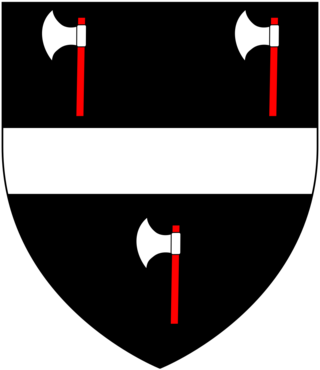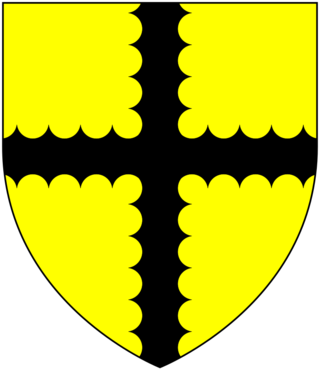
Baron de Clifford is a title in the Peerage of England. It was created in 1299 for Robert de Clifford (c.1274–1314), feudal baron of Clifford in Herefordshire, feudal baron of Skipton in Yorkshire and feudal baron of Appleby in Westmoreland. The title was created by writ, which means that it can descend through both male and female lines. The Norman family which later took the name de Clifford settled in England after the Norman Conquest of 1066 and was first seated in England at Clifford Castle in Herefordshire. The first Baron served as Earl Marshal of England but was killed at the Battle of Bannockburn in 1314. His 8th generation descendant the 11th Baron, was created Earl of Cumberland in 1525, whose grandson the 3rd Earl was a noted naval commander. On the latter's death in 1605, the earldom passed to his younger brother, the 4th Earl.

Baron Berners is a barony created by writ in the Peerage of England.
Baron Denham, of Weston Underwood in the County of Buckingham, is a title in the Peerage of the United Kingdom. It was created in 1937 for Sir George Bowyer, 1st Baronet, a Conservative politician who had earlier represented Buckingham in the House of Commons. He had already been created a baronet, of Weston Underwood, in 1933. Bowyer was a great-great-great-grandson of Sir William Bowyer, 3rd Baronet, of Denham Court. As of 2017 the titles are held by his second but only surviving son, the 2nd Baron, who succeeded in 1948. In 1950 he also succeeded his distant relative in the Bowyer baronetcy, of Denham Court. Like his father, the 2nd Baron Denham was a Conservative politician and one of the ninety elected hereditary peers that remain in the House of Lords after the passing of the House of Lords Act 1999.

Baron Swansea, of Singleton in the County of Glamorgan, is a title in the Peerage of the United Kingdom and held by a branch of the Vivian family. It was created on 9 June 1893 for the industrialist Sir Henry Vivian, 1st Baronet. He had already been created a Baronet, of Singleton in the County of Glamorgan, on 13 May 1882. He was succeeded by his eldest son, the second Baron. On his death the titles passed to his half-brother, the third Baron. As of 2014 the titles are held by the latter's grandson, the fifth Baron, who succeeded his father in 2005.

Henry Hussey Vivian, 1st Baron Swansea, known between May 1882 and June 1893 as Sir Hussey Vivian, 1st Baronet, was a Welsh industrialist and politician from the Vivian family.
Baron Vivian, of Glynn and of Truro in the County of Cornwall, is a title in the Peerage of the United Kingdom and held by a branch of the Vivian family. It was created on 19 August 1841 for the soldier Sir Hussey Vivian, 1st Baronet. He had already been created a baronet, of Truro in the County of Cornwall, on 19 January 1828. His eldest legitimate son, the second Baron, represented Bodmin in the House of Commons and served as Lord Lieutenant of Cornwall. His son, the third Baron, served as British Ambassador to Italy from 1891 to 1893. The latter's great-grandson, the sixth Baron, was a soldier and a Conservative member of the House of Lords. Lord Vivian was one of the ninety elected hereditary peers that were allowed to remain in the House of Lords after the passing of the House of Lords Act 1999. As of 2014 the titles are held by his only son, the seventh Baron, who succeeded in 2004.

Baron Bicester, of Tusmore in the County of Oxford, is a title in the Peerage of the United Kingdom. It was created on 29 June 1938 for the banker Vivian Smith. As of 2018 the title is held by his great-grandson, the fifth Baron, who succeeded his first cousin once removed in 2016.
Baron Colwyn, of Colwyn Bay in the County of Conwy, is a title in the Peerage of the United Kingdom. It was created in 1917 for the businessman Sir Frederick Smith, 1st Baronet. He had already been created a Baronet in 1912. As of 2024 the titles are held by his great-great-grandson, the fourth Baron, who succeeded his father in that year.

The Wrey Baronetcy, of Trebitch in the Duchy of Cornwall, is a title in the Baronetage of England. It was created on 30 June 1628 for William Wrey (d.1636), 2nd son of John Wrey of Trebeigh, St Ive, Cornwall, a member of an ancient Devon family. The third Baronet was a supporter of the Royalist cause and sat as Member of Parliament for Lostwithiel after the Restoration. He married Lady Anne, third daughter and co-heir of Edward Bourchier, 4th Earl of Bath, and a co-heir to the barony of Fitzwarine. The fourth Baronet represented Liskeard and Devon in the House of Commons. The fifth Baronet was Member of Parliament for Camelford while the sixth Baronet represented Barnstaple.

The Smithbaronetcy, of East Stoke in the County of Nottingham, is a title in the Baronetage of Great Britain. It was created on 31 October 1757 for the banker George Smith, High Sheriff of Nottinghamshire from 1757 to 1759. He was the eldest son of Abel Smith I (1686–1756) of Nottingham, the 2nd son of Thomas Smith I (1631–1699), the founder of Smith's Bank in Nottingham. His younger brothers included: Abel Smith II, and John Smith, ancestor of Julian Pauncefote, 1st Baron Pauncefote.

John Arundell, 2nd Baron Arundell of Trerice of Trerice, Cornwall, was an English politician who sat in the House of Commons at various times between 1666 and 1687 when he inherited his peerage.

Sir Reginald Mohun, 1st Baronet of Boconnoc in Cornwall, was a prominent member of the gentry of Cornwall and an MP.

The historic manor of Raleigh, near Barnstaple and in the parish of Pilton, North Devon, England, was the first recorded home in the 14th century of the influential Chichester family of Devon. It was recorded in Domesday Book of 1086 together with three other manors that lay within the later-created parish of Pilton. The manor lies above the River Yeo on the southern slope of the hill on top of which stand the ruins of the Anglo-Saxon hillfort called Roborough Castle. Part of the historic manor of Raleigh is now the site of the North Devon District Hospital.

Nutwell in the parish of Woodbury on the south coast of Devon is a historic manor and the site of a Georgian neo-classical Grade II* listed mansion house known as Nutwell Court. The house is situated on the east bank of the estuary of the River Exe, on low-lying ground nearly contiguous to the water, and almost facing Powderham Castle similarly sited on the west bank. The manor was long held by the powerful Dynham family, which also held adjacent Lympstone, and was according to Risdon the site of their castle until John Dynham, 1st Baron Dynham (1433–1501), the last in the male line, converted it into "a fair and stately dwelling house".
Vivian is the name of a British noble family of Cornish extraction that rose to wealth in various regions of the British Isles. Over time, several members of the Vivian family were made knights, baronets and peers. Hereditary titles held by the family include the Vivian barony as well as the Swansea barony. Several other members of the family have also risen to prominence.
John Vivian was a British industrialist. Himself a descendant of the Vivians of Trewan, Cornwall, he was the first member of this branch of the family to settle in South Wales, where he became the ancestor of the Vivian baronets and barons. He was the son of Reverend Thomas Vivian and Mary Hussey, of Truro St. Mary, Cornwall, who had been married on 30 November 1747 at Kenwyn, Cornwall.

The Lyttelton family is a British aristocratic family. Over time, several members of the Lyttelton family were made knights, baronets and peers. Hereditary titles held by the Lyttelton family include the viscountcies of Cobham and Chandos, as well as the Lyttelton barony and Lyttelton baronetcy. Several other members of the family have also risen to prominence, particularly in the field of cricket.

Nicholas Carew, Lord of Moulsford, was a baron of medieval England who took part in the Wars of Scottish Independence.

The Smith family is an English aristocratic and banking family founded by Thomas Smith (1631–1699), the founder of Smith's Bank of Nottingham. Its members include the Marquess of Lincolnshire (extinct), the Viscount Wendover (extinct), the Barons Carrington, the Baron Pauncefote (extinct), the Barons Bicester, the Bromley baronets and many Members of Parliament. Originally named Smith, the branch of the Barons Carrington assumed the surname Carington, the branch of the Bromley baronets the surname Bromley and the branch of the Baron Pauncefote the surname Pauncefote.